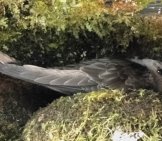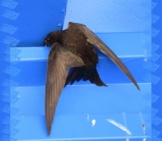Black Swifts are small birds in the swift, or Apodidae, family. They have small bodies and long wings, which they use to speed through the air after flying insects.
Their plumage is black or dark grey, which blends in well with the cliffs and caves that they roost and nest in. This swift species lives throughout portions of the western coast of North America. Read on to learn about the Black Swift.
Description of the Black Swift
These are small birds, usually just seven inches long and weighing no more than two ounces. Their plumage, or feathers, is black or dark grey in color. Their wings are long and pointed at the tips, and their bodies are quite small. They also have very small beaks, which point slightly downward at the tip.
Interesting Facts About the Black Swift
This little bird is relatively uncommon and rare throughout its range. Learn what makes Black Swifts unique below.
- Mysterious Creatures – Researchers do not have very much information about these little birds. They are rare, and difficult to study in the wild. They are elusive birds, and usually do not stray too close to human habitation.
- Newfound Discoveries – As technology improves throughout the years, scientists are able to make new discoveries about animals. In fact, researchers did not know where these birds spend their winters until recently! They studied the migration patterns of Black Swifts by placing smalls GPS trackers on a handful of birds.
- Massive Migration – Those researchers discovered that these diminutive birds migrate all the way to the Brazilian rainforests to spend the winter. This means that they migrate about 4,000 miles every year. That is a long undertaking for a seven-inch-long bird!
- Buggy Bolus – While hunting, swifts do not just swallow each bug that they snatch up. Instead, they collect the bugs in a ball of saliva in the backs of their throats. Researchers call this saliva-insect ball a “bolus.” When they have hatchlings, the swifts return to the nest and regurgitate this bolus for the chicks to eat.
Habitat of the Black Swift
Black Swifts roost and build their nests on cliffs, inside crevices, and in sea caves. They also live near or behind waterfalls. When they leave their roosts to forage, they hunt primarily in open areas.
Some foraging grounds include grasslands, meadows, and over the tops of forests. They inhabit areas from sea level all the way to mountainous regions.
Distribution of the Black Swift
These birds have patchy distribution across the western portion of North America. They live in Southwest Canada during the spring and summer, migrate south along the coast of the United States and Mexico, and spend their winter in South America.
A large population also breeds on the western coast of Mexico. Some populations also live in the Caribbean islands year-round.
Diet of the Black Swift
Like all swifts, birds of this species are insectivores and feed primarily on insects. They hunt flying insects, which they snatch straight out of the sky. On clear days they hunt high in the sky, but during overcast conditions they fly lower to forage.
Some common prey items include winged ants, flies, mosquitoes, beetles, and more. Small flocks of swifts often feed on the same swarm of insects.
Black Swift and Human Interaction
Black Swifts have small populations that breed in different areas. This makes them especially vulnerable to human activity, and their populations are in decline.
The IUCN lists this species as Vulnerable. Researchers aren’t quite sure why these birds’ populations are declining. Some scientists believe that climate change and pesticides are impacting their insect prey.
Domestication
Humans have not domesticated this species in any way.
Does the Black Swift Make a Good Pet
No, Black Swifts do not make good pets. With declining populations, every single individual is important for the survival of the species. It is also illegal in most places to own one as a pet.
Black Swift Care
There are not many of these birds in human care, so we know very little about their care. We can assume that their enclosures would need to be quite large, because they fly at very high altitudes and swift speeds.
Zookeepers would also likely feed them a variety of insects and insectivore pelleted feed. Because they are social, zoos would need to house them in groups or with other social swift species.
Behavior of the Black Swift
These birds spend most of their time in the air. Their legs are short, and simply not made to stand on the ground or land in trees. Instead, swifts spend all their time either in their roosts or in the air.
They fly at very high elevations while searching for food. They are also quite social, and they live and forage in small groups. Some of these birds also interact with other species of birds.
Reproduction of the Black Swift
This species builds a small nest in a rock crevice or cave. Some other species use their saliva to build their nest, but Black Swifts usually use a mixture of mud and moss instead. Females lay a single egg, and usually incubate it for around three weeks to a month.
The young are completely helpless, and both parents participate in feeding and caring for them. It takes about a month and a half or two months before the chicks learn how to fly.







![Red Angus Closeup of a beautiful Red Angus cowPhoto by: U.S. Department of Agriculture [pubic domain]https://creativecommons.org/licenses/by/2.0/](https://animals.net/wp-content/uploads/2020/03/Red-Angus-4-238x178.jpg)












![Red Angus Closeup of a beautiful Red Angus cowPhoto by: U.S. Department of Agriculture [pubic domain]https://creativecommons.org/licenses/by/2.0/](https://animals.net/wp-content/uploads/2020/03/Red-Angus-4-100x75.jpg)

